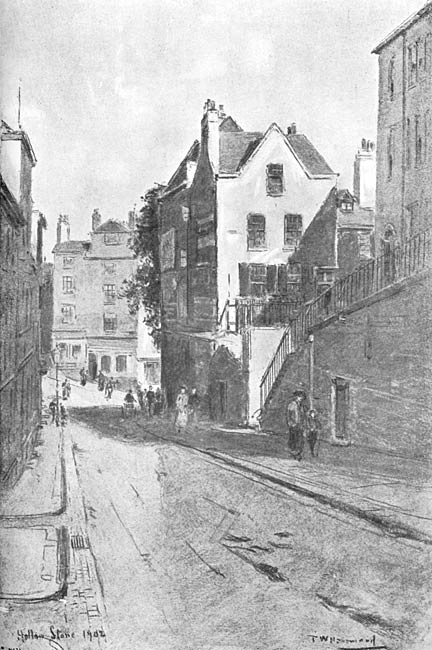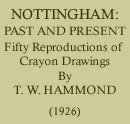< Previous | Contents | Next >
NOTTINGHAM PAST & PRESENT: STREETS AND YARDS
HOLLOW STONE, 1902

Hollow Stone as a thoroughfare is not as ancient as some of our other roads. Before wheeled traffic was in general use, the road through Nottingham running from the south of England to the north, passed along Narrow Marsh and up Drury Hill, but in later times, when wheels were generally used, a fresh thoroughfare was made, which came up the steep hill to St. Mary's Church, passed along the Pavements and joined the old road at the top of Drury Hill. The ascent to St. Mary's Church was hollowed out of the rock and hence its name 'Hollow Stone'. It has been reconstructed and modified in comparatively modern times, but still retains some of its interesting associations and features. At its foot, just where it joins Plumptre Square, stood one of the gateways through the defences of the town, erected by Henry II. about 1154, and there are still traces of some of the rock hewn chambers, which were used by the guards of this gateway. In the middle of this picture, where the road turns to the right, stands an uninteresting looking modern front to an old building. This is the public house with the strange title of 'Home's Castle'. William Andrew Home was an old reprobate, but a man of considerable wealth who pursued his evil courses until he reached the ripe age of seventy-four, when Nemesis overtook him and he was arraigned for a murder which he had committed some twenty years before. In 1759 he was convicted and sentenced to death. He was driven from his own house—this Home's Castle—to the gallows, which stood near to the site of St. Andrew's Church, by his own coachman in his own carriage. He expressed no contrition for his many misdeeds, but was much chagrined because the authorities refused to allow him to eat a plum pudding; for he had been accustomed to have a plum pudding at twelve o'clock on his birthday for many years, and the authorities had fixed upon his birthday as the day of his execution and refused to allow him to live until after twelve o'clock.
On the right of the picture, at the end of Short Hill, is a fine gabled Tudor house, which was used during the last century as a school house, but is now occupied for commercial purposes.
